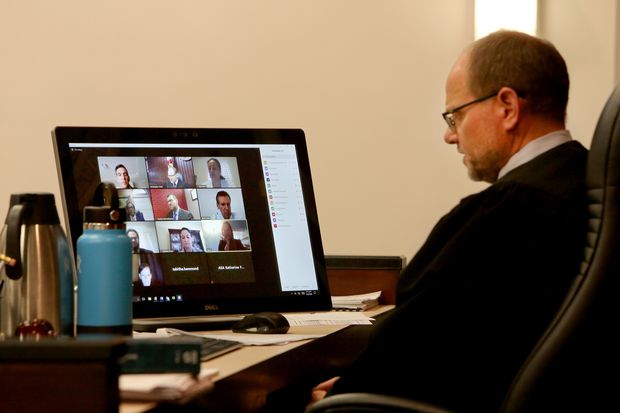Matter of Haydee F. v. ACS-NY, NYLJ November 16, 2020, Date filed: 2020-10-28, Court: Family Court, New York, Judge: Referee Pamela Scheininger, Case Number: G-15246-19:
"This decision comes in response to three cases in which one or more
parties has objected to participating in a contested virtual hearing in
New York County Family Court. In compliance with New York State Governor
Andrew Cuomo’s Executive Order and Administrative Orders from Chief
Judge Janet DiFiore and Chief Administrative Judge Lawrence Marks,
hearings in Family Court are currently taking place virtually, via Skype
for Business and/or Microsoft Teams. In the instant case, an Article
Ten petition was filed against respondent parents, Catherine D. and
Martin F. on July 7, 2016 as to four subject children, including the two
subject children at issue in the present case, Aracelis D. (dob
1/21/10) and Katalaya F. (dob 7/6/10). A fact finding order of neglect
was entered against Catherine D. on January 24, 2017 based on her
submission to the jurisdiction of the court pursuant to Family Court Act
§1051(a) and on March 10, 2017, an order of disposition was entered
against Ms. D. releasing the children to her care pursuant to Family
Court Act §1054 on terms and conditions. With respect to Martin F., an
order was issued adjourning his Article Ten case in contemplation of
dismissal on March 28, 2017.
On September 7, 2017, the Commissioner
of Social Services filed a petition alleging that Mr. F. had violated
the terms of the adjournment in contemplation of dismissal. On March 1,
2018 the Commissioner filed a petition to modify the dispositional order
and place the subject children in the care of the Commissioner. The
children were subsequently placed with the Commissioner in two separate
kinship foster homes.
On August 12, 2019, the permanency goal for
Aracelis and Katalaya was changed from return to parent to placement
with a fit and willing relative, On December 23, 2019, Jessica G. filed a
kinship guardianship petition as to the child, Catalaya F. and Haydee
F. filed a guardianship petition as to the child, Aracelis. Issue was
joined on that case on February 26, 2020. The matter was set down for a
hearing on May 6, 2020.
Due to the global COVID-19 pandemic, this
guardianship case did not go forward on May 6, 2020 and it was not until
August 26, 2020 that the case was held in Virtual Court for a
permanency hearing. The guardianship hearing was scheduled for October
26, 2020. Counsel for Ms. D. and Mr. F. objected to holding the
guardianship hearing virtually and each filed a motion for an
adjournment until an in-person hearing could be held. The attorney for
the petitioner, attorney for the Commissioner and attorney for the child
each filed affirmations in opposition to the motions.
It goes
without saying that these are unprecedented times. A global pandemic of
this nature has not been experienced in over a century and none of us
could have anticipated the extent and the length of the impact of
COVID-19. Indeed, standing here today, we cannot know how long this
pandemic will last and the full extent of its devastation.
Family
Court carries a heavy burden. We are the court to which people turn when
they are experiencing domestic violence, when they need financial
support to ensure the health and wellbeing of their children, when the
State must protect a child from abuse or neglect, when a parent is
denied access to a child and when a child is in need of a permanent home
and a forever family. Family Court jurists (and indeed, jurists in all
of our courts) have been working steadily through this pandemic,
initially through Virtual Parts limited to “essential matters” then also
through Virtual Chambers, and finally through expanded Virtual Parts
which provide greater capacity to hear matters beyond those which fall
strictly within the category of “essential.”
Currently, in
compliance with Family Court protocols and procedures, jurists are able
to hear permanency hearings and custody and guardianship cases which
commenced prior to March 2020. Matters which may be heard and the number
of Virtual Parts available to hear such cases have increased steadily
as the New York City Family Court operations expand. There is still no
certainty as to when regular, daily in-person hearings will resume in
New York City Family Court.
With respect to practices and protocols
which have been communicated by Administrative Judge of the Family
Court, Judge Jeannette Ruiz, or Supervising Judge of Manhattan Family
Court, Judge Karen Lupuloff, those practices and protocols, though
accurate at the time of their making, have been fluid and ever-changing.
Every day, Family Court pushes itself to be more open and available to
the people who need us and practices and protocols are under constant
review and evolving in order to meet those needs.
With respect to
the court’s authority to hear virtual cases, as stated by Judge Jeffery
Sunshine in C.C. v. A.R., 2020 Slip Op 29245 at *6 (Sup Ct. Kings Co.
2020):
“Pursuant to New York Judiciary Law §2-b(3), the Court has
the power ‘to devise and make new process and forms of proceedings,
necessary to carry into effect the powers and jurisdiction possessed by
it.” This authority is vested in the Courts by the New York State
Constitution which permits courts latitude to adopt procedures not
specified in the statutes where such procedures are consistent with
general practice as provided by the law. (NY Const Art VI, 30, see also
People v. Ricardo, 73 NY2d 228, 232 [1989]).”
In his decision, Judge
Sunshine cited People v. Wrotten, 14 NY3d, 33, 37 (2009) where the
Court of Appeals “ruled that the Court “does not need the consent of the
parties to fashion “innovative procedures” where “necessary” to
effectuate the power and jurisdiction of the Court.” Id at *6. In People
v. Wrotten, the Court of Appeals held that live televised testimony is
to be used in “exceptional circumstances” as “necessary.” People v.
Wrotten, 14 NY3d 33, (2009). Judge Sunshine further wrote that: “As the
Court of Appeals has noted again and again, “in this imperfect world,
the right of a defendant to a fair appeal, or for that matter, a fair
trial, does not necessarily guarantee him a perfect trial or a perfect
appeal.” (People v. Rivera, 39 NY2d 519, 523 [1976]; see also People v.
Harris, 57 NY2d 335 [1982]; People v. Parris, 4 [*8] NY3d 41 [2004]).”
Id at *7.
Similarly, in Ciccone v. One 64th St., Inc., 2020 Slip Op
20220 (Sup. Ct. NY Co. 2020), Judge Gerald Lebovits held that “the Court
of Appeals and the Appellate Division, First Department, have
repeatedly held that one such [innovative] procedure that courts may
employ, albeit in exceptional circumstances, is the use of video
testimony…” Ciccone at *2
Judge Lebovits further noted that:
“The federal trial courts considering the issue have acknowledged that
“[c]onducting a trial by videconference is certainly not the same as
conducting a trial where witnesses testify in the same room as the
factfinder,” and that “[c]ertain features of testimony useful to
evaluating credibility and persuasiveness, such as the immediacy of a
living person can be lost be video technology.” Matter of RFC &
RESCAP Liquidating Trust Action (444 F Supp 3d 967, 970 [D Minn. Mar
13,2020] [internal quotation marks omitted].) At the same time, these
courts have found that given “advances in technology,” “the near
instantaneous transmission of video testimony” permits the court “to see
the live witness along with his hesitation, his doubts, his variations
of language, his confidence or precipitancy, and his calmness or
consideration.” (Id. [internal quotation marks and alteration omitted] ;
accord Gould Elec. Inc.v. Livingston County Rd. Commn. (2020 WL
3717792, at 6 [ED Mich June 30, 2020 [same]; United States v. Donziger
(2020 WL 5152162, at *3 n 4 [SD NY Aug. 31, 2020].” Id at *3-4.
He added that:
“Federal court have also found that given the “unprecedented nature of
the circumstances faced by our society at present” due to the COVID-19
pandemic, compelling reasons exist to conduct trials virtually. (Flores
v. Town of Islip (2020 WL5211052 at *2 [ED NY Sept. 1,2020]; accord RFC,
444 F Supp 3d at 972 [concluding that COVID-19's unexpected natures,
rapid spread, and potential risk establish good cause for remote
testimony"].) And given the court closures required by the pandemic,
“the months’ long delay that has resulted” and the continuing lack of
clarity about when it will be safe to resume normal in-person
operations, the courts have concluded that “it is ‘absolutely
preferable’ to conduct the bench trial via such ‘contemporaneous
transmission’…rather than to delay the trial indefinitely.” (Argonaut
Ins. Co. v. Manetta Enters., Inc. (2020 WL 3104033, at *2 [ED NY June
11, 2020], quoting RFC, 44 Supp 3d at 927.)” Id at *4.
Specifically,
in the context of a virtual custody hearing, Justice Tandra L. Dawson
ruled that a custody trial would proceed virtually over the objections
of counsel stating:
“While the court is cognizant of the limitations
and inherent difficulty involved in conducting virtual hearings,
counsels’ objection do not set forth a prejudicial basis to further
delay the hearing. Given the unpredictable nature of the COVID-19
pandemic it is unknown when court operations will return to normal
in-person procedures, particularly given a resurgence is anticipated, if
not already occurring, with multiple travel bans and advisories in
effect. The court is mindful that compelling in-person attendance, in a
courtroom, could subject vulnerable individuals to an increased risk of
harm. Virtual technology would remove that risk.” A.S. v. N.S., 2020 NY
Slip Op 20161 (Sup Ct, NY Co. 2020).
In addressing this issue, it
bears mention that there are New York statutes which expressly allow for
testimony by telephone, audio-visual or other electronic means. For
example, under the Uniform Interstate Family Support Act (UIFSA), “In
any proceeding under this article, the court may permit a party or a
witness to be deposed or to testify by telephone, audio-visual means, or
other electronic means at a designated family court or other location.”
See N. Y. Fam Ct Act §531-a (1). Also, under the Uniform Child Custody
and Jurisdiction Enforcement Act (UCCJEA), “A court of this state may
permit an individual residing in another state to be deposed or to
testify by telephone, audiovisual means, or other electronic means
before a designated court or at another location in that state. A court
of this state shall cooperate with courts of other states in designating
an appropriate location for the deposition or testimony and the
procedures to be followed by the persons taking such deposition or
testimony. Any such testimony or deposition shall be recorded and
preserved for transcription.” See N.Y. Domestic Relations Law §75-j(2).
Long before the exceptional circumstances created by COVID-19,
considerations of time and money led the New York State Legislature to
adopt electronic testimony (including telephone testimony) as a reliable
and competent means of conducting a hearing.
According to the Pew
Research Center, as of February 7, 2019, 96 percent of all Americans
owned a cell phone with 81 percent of all Americans owning a smart
phone.
https://www.pewresearch.org/internet/fact-sheet/mobile/.
Though
this study demonstrated variability based on race, gender, age, income
and rural vs. urban dwellers, no group dropped below 91 percent in cell
phone ownership or 71 percent in smart phone ownership (other than those
over 65 years of age and those who had not yet graduated high school
which both reported at 53 percent in smart phone ownership). Id. Simply
put, as of 2019, almost all Americans owned cell phones and the vast
majority of them owned smart phones. The technologies being employed to
conduct virtual hearings in Family Court are accessible via phone or
smartphone and are readily available to anyone who owns either a cell
phone or smart phone.
With respect to arguments by counsel for Ms.
D. that electronic testimony is unreliable or prejudicial, we note that
the studies cited in support of such an argument are all at least ten
years old, with some dated as early as the 1980′s. It goes without
saying that the electronic testimony that was available in 2010 and
earlier is not the electronic testimony that is available today. During
COVID-19, courts across this country have become virtual, as have
businesses, law firms, doctor’s offices, schools and universities.
People are relying on platforms such as Zoom, Skype for Business and
Microsoft Teams to conduct multi-billion dollar deals, educate students,
conduct hearings and save lives. We are able to rely on these platforms
because they are easy to access and they work.
Given these
considerations and the fact that electronic testimony has long been
utilized in Family Court, this Court find arguments by counsel for the
parents that electronic testimony is unreliable and/or prejudicial to be
unpersuasive. The court is no less able to make credibility findings in
hearings which are conducted virtually than in hearings conducted in
person.
With respect to the interest of the State in conducting
these hearing in a timely manner, it must be noted that the hearings in
question here are all related to Article Ten proceedings and being
sought in an effort to achieve permanency for the children involved. The
court and the State are seeking to conduct these virtual hearings
because without a determination as to the permanency hearings, custody
and guardianship cases, these children will continue to languish in a
state of uncertainly and instability. The Adoption and Safe Families Act
states: ”(C) if continuation of reasonable efforts of the type
described in subparagraph (B) is determined to be inconsistent with the
permanency plan for the child, reasonable efforts shall be made to place
the child in a timely manner in accordance with the permanency plan,
and to complete whatever steps are necessary to finalize the permanent
placement of the child.” Public Law 105-80, 105th Congress, Section 101.
We are acutely aware of the deleterious impact of delayed permanency on
the psychological and emotional health of children in foster care.
“Paramount in the lives of these children is their need for continuity
with their primary attachment figures and a sense of permanence that is
enhanced when placement is stable.” Pediatrics November 2000, 106 (5)
1145-1150; DOI: https://doi.org/10.1542/peds.106.5.1145. Moreover,
“[c]hildren who have experienced abuse or neglect have a heightened need
for permanency, security, and emotional constancy and are, therefore,
at great risk because of the inconsistencies in their lives and the
foster care system. Every effort should be made to rapidly establish a
permanent placement for the child.” Id.
Unless and until a child is
adopted, returned to a parent or placed in a permanent home with a fit
and willing relative through a final order of custody or guardianship,
permanency has not been achieved. Foster care agencies will continue to
conduct home visits and interview these children, court ordered visits
with parents will continue to take place at the foster care agencies or
other locations, and the home will continue to be under the stress
associated with frequent court appearances. Moreover, in the cases
before us, the parties are engaged in litigation over what the
permanency plan should be for the children. Without a hearing and
determination of these matters, it is impossible to know what these
children’s future looks like or to make any assurances. These children
are struggling with insecurity and uncertainty and suffering from the
associated social, emotional and psychological stressors that this
insecurity and uncertainty brings. Arguments that a parent’s right to
the trial of their choosing outweighs a child’s right to permanency in
their lives is not persuasive.
Similarly, the arguments made by
counsel for the parents as to ineffective assistance of counsel are
unpersuasive. The attorneys in these cases would have ample opportunity
to meet with their clients in person, masked and socially distanced or
via phone or teleconference. Attorneys are able to participate fully in
virtual hearings, directing and cross-examining witnesses and making
objections and applications as appropriate. If there is a problem with
the technology and a witness or attorney cannot hear or be heard, the
hearing can be stopped until the issue is addressed. If the issue cannot
be addressed that day, another hearing date can be chosen. During the
hearing, attorneys and clients can communicate via text or email, they
can ask for breaks and/or to go off the record in order to consult
further. Adjournments can be granted between direct and cross
examination and after each party has rested in order to allow for
further consultation.
While it is true that a party may be more
comfortable sitting next to their attorney and better able to
participate in the process, our world has moved online and people have
adapted, continuing to attend classes, see doctors and therapists, and
visit with family and friends. Nothing takes the place of in-person
contact but in these unprecedented times, Family Court must continue to
meet the needs of its families. As stated by Judge Sunshine, a litigant
has the right to a fair trial not a perfect trial. With the protections
listed above put into place, fair trials occur.
This having all been
said, in the instant matter, the court does find that in this contested
virtual guardianship hearing, the witnesses must testify via video
rather than telephone. Counsel have made valid arguments to the Court as
to the potential unreliability of telephone testimony, including the
inability to know whether a witness is reading from notes or another
source, and whether the witness is in the presence of someone who is
coaching them or preventing them from testifying truthfully. Further,
counsel for the parents are persuasive in their arguments that it is
challenging to make accurate credibility findings when one cannot see a
witness’s face and facial expressions and that testimony via telephone
would place a hindrance on an attorney’s ability to engage in fully
effective advocacy.
Accordingly, parties are directed to provide the
court and counsel with witness lists within two weeks with information
as to whether each witness will be able to testify via video, and if
not, an explanation as to why not. The court can then make inquiry and
issue orders to address challenges with internet access and video
capability. We are mindful that in the cases before us, it is likely
that while agency personnel may have ready access to computers and
internet, parents and foster parents may not. Given the availability of
foster care agencies and their resources, there are any number of ways
to ensure that all parties may appear via video. These hearing will then
proceed via Skype for Business and/or Microsoft Teams. An application
for a limited number of participants to appear virtually, from a monitor
specifically set up for such person in our courthouse, while others
appear virtually from law offices and other locations, may also be made
for this Court’s consideration.
This matter is adjourned to November 9, 2020 at 2:00 p.m. in Part 43 for a virtual court appearance via Microsoft Teams."
















